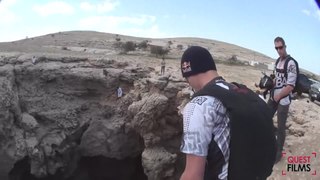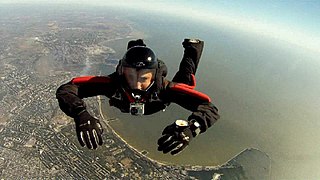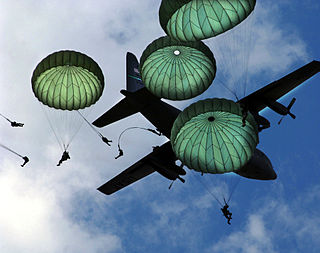
BASE jumping is the recreational sport of jumping from fixed objects, using a parachute to descend safely to the ground. "BASE" is an acronym that stands for four categories of fixed objects from which one can jump: buildings, antenna, spans (bridges), and earth (cliffs). Participants exit from a fixed object such as a cliff, and after an optional freefall delay, deploy a parachute to slow their descent and land. A popular form of BASE jumping is wingsuit BASE jumping.

A parachute is a device used to slow the motion of an object through an atmosphere by creating drag or, in a ram-air parachute, aerodynamic lift. A major application is to support people, for recreation or as a safety device for aviators, who can exit from an aircraft at height and descend safely to earth.

Paragliding is the recreational and competitive adventure sport of flying paragliders: lightweight, free-flying, foot-launched glider aircraft with no rigid primary structure. The pilot sits in a harness or lies supine in a cocoon-like 'speed bag' suspended below a fabric wing. Wing shape is maintained by the suspension lines, the pressure of air entering vents in the front of the wing, and the aerodynamic forces of the air flowing over the outside.

The 3-ring release system is a parachute component that is widely used by sport skydivers and military freefall parachutists to attach the two risers of a main parachute to the harness that bears the load under the parachute.

Bill Booth is an American engineer, inventor, and entrepreneur in the skydiving equipment manufacturing industry. His invention of the 3-ring release safety device has enhanced skydiving safety. He founded the companies United Parachute Technologies and Complete Parachute Solutions, which had 150 employees as of 2015.

In skydiving, an automatic activation device (AAD) is a dead man's switch consisting of an electronic-pyrotechnic or mechanical device that automatically opens the main or reserve parachute container at a preset altitude or after a preset time.

A slider is a small rectangular piece of fabric with a grommet near each corner used to control the deployment of a "ram-air" parachute. Also called a "reefing device." A ram-air parachute has a tendency to open very rapidly. At high velocities, the opening shock from a rapid deployment can cause damage to the canopy or injury to the jumper. The slider was developed as a way of mitigating this. During deployment, the slider slides down from the canopy to the risers. Air resistance slows its descent. The slider holds the lines together, which slows the parachute inflation. The slider also deflects some of the rising air column away from the center of the canopy as it inflates. This also helps moderate the speed of opening. This invention solved the rapid deployment problem with ram-air designs. Sliders also reduce the chance of the lines twisting to cause a malfunction.

A static line is a fixed cord attached to a large, stable object. It is used to open parachutes automatically for paratroopers and novice parachutists.
"Blood on the Risers" is an American paratrooper song from World War II. It is associated with all current airborne units, including the 82nd Airborne Division, the 173rd Airborne Brigade and 4th Brigade Combat Team (Airborne) of the 25th Infantry Division, and the 120th CTS as well as British airborne units. It is known as "Mancha Roja" in airborne units from multiple Latin American countries. In Spain it is called "Sangre en las cuerdas".

A pilot chute is a small auxiliary parachute used to deploy the main or reserve parachute. The pilot chute is connected by a bridle to the deployment bag containing the parachute. Pilot chutes are a critical component of all modern skydiving and BASE jumping gear. Pilot chutes are also used as a component of spacecraft such as NASA's Orion.

Tandem skydiving or tandem parachuting refers to a type of skydiving where a student skydiver is connected to an instructor via a harness. The instructor guides the student through the whole jump from exit through freefall, piloting the canopy, and landing. The student needs only minimal instruction before making a tandem jump with the instructor. In the United States most skydiving centers and clubs require that you be 18 years or older to skydive whereas in other countries the minimum age can be lower or higher. This is one of three commonly used training methods for beginning skydivers; the others being Static line, Instructor-assisted deployment (IAD), and Accelerated freefall (AFF) (k).
The Skyhook is United Parachute Technologies version of a Main-Assisted Reserve Deployment system (MARD), a safety feature on skydiving parachute systems. It builds on the concept underlying an ordinary reserve static line (RSL), which uses the force of the departing main parachute to open the reserve parachute compartment after the malfunctioning main parachute is cut-away, by further using the force of the departing main parachute to extract the reserve parachute out of the reserve compartment. This greatly decreases the time, and hence loss of altitude, required to fully open the reserve parachute.
Cut-away is a skydiving term referring to disconnecting the main parachute from the harness-container in case of a malfunction in preparation for opening the reserve parachute. The 3-ring release system on parachutes allows a rapid cut-away in the event of an emergency.

A reserve static line, occasionally called a Stevens Lanyard, is a device that automatically opens the reserve parachute container when the main parachute is cut-away. The RSL is a lanyard connecting one or both of the main parachute risers to the reserve ripcord.

Accelerated freefall (AFF) is a method of skydiving training. This method of skydiving training is called "accelerated" because the progression is the fastest way to experience solo freefall, normally from 10,000 to 15,000 feet above ground level (AGL). In static line progression, more jumps are required to experience freefall, but the jumps are less expensive for the student as one instructor can dispatch multiple students per load and students are initially dispatched from lower altitudes. Under accelerated freefall, one or sometimes two instructors are dedicated just to one student.
The death of Stephen Hilder, aged 20, occurred on 4 July 2003 at Hibaldstow Airfield, England, in an incident in which Hilder fell 4,000 metres (13,000 ft) to his death when, during a 3-person team skydive, both his main and reserve parachutes failed. The investigation into the death, "unique in British crime history", revealed expert-level tampering with both canopies, but failed to determine whether the incident was murder or suicide.

Parachuting, including also skydiving, is a method of transiting from a high point in the atmosphere to the surface of Earth with the aid of gravity, involving the control of speed during the descent using a parachute or parachutes.

The T-10 Parachute is a series of static line-deployed parachutes used by the United States armed forces for combat mass-assault airborne operations and training. The T-10 parachute was introduced in the early 1950s. In 1976, the B model introduced the anti-inversion net; in 1986, the C model was introduced, which changed the pocket band free length from 4" to 7½". The T-10D, adopted in 2000, includes the detachable pack tray, which in itself includes the 15' universal static line and 5' extension static line. The T-10D is currently being replaced by the T-11 parachute system. In 2006, all T-10C parachutes were revised by adding one static line stow bar to each side of the pack tray; the material for the T-10C was also changed to the muddy water 407.
A closing pin is a curved piece of stainless steel metal used in the sport of skydiving. The pin is sewn onto the bridle, which is a 7- to 10-foot-long piece of nylon webbing connected to the pilot chute. The closing pin passes through the closing loop and in doing so, secures the main container of a skydiving rig, keeping the parachute from deploying prematurely. When the pilot chute is thrown out by the skydiver and catches air, it pulls the closing pin from the closing loop and allows the main parachute to be released from the container and inflate.
A Main-Assisted Reserve Deployment (MARD) system is a skydiving safety device for parachute systems. While there are many variations, the operation and intended outcome for each is the same: open the reserve parachute container and extract the reserve parachute's deployment bag using the jettisoned main canopy. A MARD builds upon how a Reserve static line (RSL) safety device works and in most circumstances, MARDs incorporate an RSL.
















